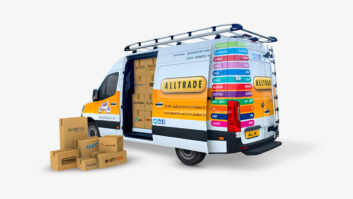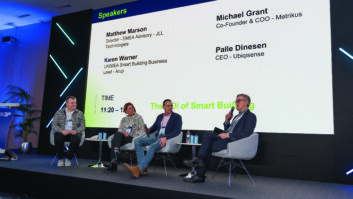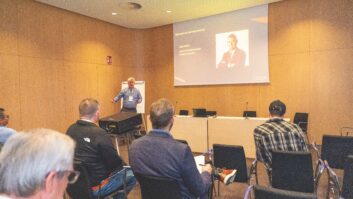What does 2022 hold in store for the residential AV market and for integrators? Let’s look ahead at what the next 12 months may bring, both in terms of technology trends and the custom install business as a whole, before piquing your curiosity with some blue sky predictions – for instance, is the biggest threat to custom install actually the metaverse?
When it comes to scene-setting, ISE 2022 is always a good place to start. This year it promises to foreshadow the evolving residential AV market, with clearly defined technology zones dedicated to smart home technologies, lighting and audio video.
“I think the approach reflects what both integrators and end-users are demanding,” says Stijn Ooms, director product strategy AV and digital workplace at Crestron.
“Increasingly they want to see solutions that line up perfectly with their specific needs, and they want to be able to identify who can provide those solutions quickly.”
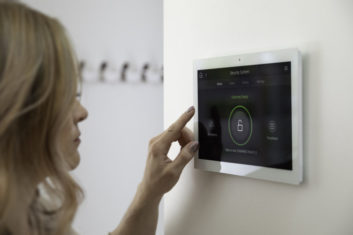 When it comes to trends, Ooms is tipping artificial intelligence. “I think the advances in AI as it applies to audio and video solutions are going to be astounding,” he says. “My feeling is that 2022 will be a year of small revolutions that lead to one big evolution, something critical: AV companies will completely move beyond simply selling gadgets and black boxes.”
When it comes to trends, Ooms is tipping artificial intelligence. “I think the advances in AI as it applies to audio and video solutions are going to be astounding,” he says. “My feeling is that 2022 will be a year of small revolutions that lead to one big evolution, something critical: AV companies will completely move beyond simply selling gadgets and black boxes.”
Terms such as ‘technology integration’ will finally begin to realize their full potential, he adds. “What we can provide is a true experience, not just a bunch of circuitry and wires.”
EVOLVED REVOLUTION
Evolution or revolution? Residential audio specialist distributor Redline believes the year ahead will see a little of both. Managing director Martin Morecroft predicts “a strong increase in discrete and semi discrete audio as awareness continues to grow exponentially”. The invisible plaster-over loudspeaker market will continue to find fresh applications and new evangelists.
“Existing brands are upping their game in the invisible speaker world with new lines, and we think some new players are waiting in the wings,” he teases. “Healthy competition breeds innovation and this can only be a good thing. Also, there are still many interior designers, architects and even installers out there who don’t know what is truly possible in the ‘hidden’ audio world. As far as we are concerned the more focus, buzz and hype on invisible audio products, the better it is for everyone.”
Morecroft predicts that the second half of 2022 will see leading audio brands unveil new technology and products – “these will push the boundaries of invisible speaker performance. We can’t wait!” – stimulating new residential AV revenue streams.
As interior designers and architects really get to grips with the fact that they can now offer all the audio quality their clients desire, without defacing their design concept with obvious technology, growth will accelerate, he says.
DRY AMBITION
Industry ambition certainly hasn’t been dampened, despite the global challenges it’s faced the last two years, says Morecroft. “At Redline we feel well placed to service this inevitable invisible market growth. We not only offer hidden audio from the pioneers of invisible speakers, Amina, but also semi discrete ‘real’ bass from the world-class subwoofer brand, Velodyne.” 2022 will see a raft of exciting new CI products from Velodyne as they expand their ranges, confirms Morecroft.
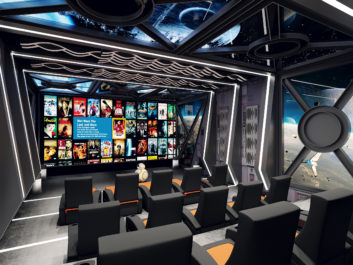 Mark Reynolds, senior director EMEA at Snap One, which brands include Control4, Araknis, Binary, Episode, Luma, OvrC, Pakedge, Strong, and Triad, predicts that more sophisticated smart lighting and an improved end-user experience will dominate resi-trends.
Mark Reynolds, senior director EMEA at Snap One, which brands include Control4, Araknis, Binary, Episode, Luma, OvrC, Pakedge, Strong, and Triad, predicts that more sophisticated smart lighting and an improved end-user experience will dominate resi-trends.
“As automation and lighting technologies have progressed to offer solutions that combine fixture-level control with whole-home programming, it’s now possible for average homeowners to enjoy the lifestyle benefits of highly-customised lighting design,” he says.
“Lighting control has also become increasingly popular, with current building trends and consumer tastes moving toward ultra-efficient whole-home LED lighting.”
The user experience also continues to be a top concern for end-users and integrators, says Reynolds. “Integrators need to look for brands that offer intuitive and simple interfaces to make sure their customers feel comfortable with new and evolving technologies.”
MOOD CHANGE
He cites Control4 OS 3 as an easy way for end-users to design and save select presets to change the mood or ambiance across multiple rooms at the touch of a button.
“End-users are increasingly insisting on peace-of-mind in the form of aftercare support from their integrator, in both the residential and commercial sectors. We believe this should be de-facto on all projects. Snap One’s OvrC remote management solution, paired with Parasol 24/7 technical support, supports integrators to offer exceptional post-sales support remotely.”
An improved user experience breeds customer confidence, and will continue to drive automation adoption in Europe, says Reynolds.
When it comes to sector segregation, Reynolds notes: “In reality, this has been happening for a number of years as different channels and technologies have matured and merged together. Thinking back to ISE ten years ago, we had segmented channels of integrators, resellers and VARs selling ProAV, IT, security and networking solutions independently.
“As these technologies merged over the last few years under the control/automation umbrella for both pro and residential projects, integrators have also adapted to sell broader, all-encompassing solutions. ISE continues to reflect our dynamic market as it continues to evolve.”
UPBEAT OUTLOOK
The mood at large is upbeat when it comes to residential AV, says Mike Beatty, CEO of Pulse Cinemas, as interest in home entertainment systems continues to boom. “We’ve seen many of our dealers report significant growth in all areas of our sector. Pulse Cinemas invested massively during 2021 to ensure our business could offer our installer partners the support they deserved. I’m delighted to report a record year for our business; during a year packed with continued uncertainty.
“Home entertainment has become a must-have addition to any home and we have a network of accomplished AV installers prepared to do everything possible to go that extra mile, offering sound and picture almost better than being at the actual event.”
Beatty says Pulse is in the inspiration game. “We are hugely excited about our recent showroom improvements and would encourage dealers who have never experienced our facilities, to make the journey along to Stansted, where they’ll find an experience centre like no other! In our opinion, our cinemas are simply stunning; elegant in design and sound and picture like you’ve never experienced.”
So does Beatty have any top tips for integrators going into 2022?
“After 20 years of running Pulse Cinemas, I’d suggest there are no ‘secrets to success’. Exceeding expectations, encouraging our team to continually improve, learning from mistakes wherever possible and reinvestment, has always been at the forefront of our minds.”
POTENTIAL GROWTH
Beatty also believes that lighting is a potential growth area for many residential integrators.
“As Lutron’s number one residential lighting and window shading partner for UK dealers and installers, we believe this sector remains underdeveloped and misunderstood by many AV installers. The potential of additional business is mouth-watering and we would urge any business installing equipment into homes to ensure money isn’t being left on the table.
Always inform clients early on about the potential benefits of adding mood lighting and window shading to their beautiful homes.”
WILD IDEAS
So where is residential AV and immersive technology ultimately heading? Let’s take a walk on the wild side…
Rory Kenny, CEO of music technology company Loudly, and Blue Sky visionary, believes we’ve seen only a tip of an iceberg of functionality when it comes to AI services like Siri and Alexa, with many more innovations to come as our homes become more interconnected.
“If built correctly, AI is very good at making predictions based on learning about our daily habits. When it comes to how AI will evolve in the home, we can imagine that it will become intertwined directly in our energy usage, home grocery shopping, water usage, waste disposal, security & lifestyle. These are all meaningful areas where AI can either automatically reduce costs or enable homeowners to become more efficient in their usage of energy, water, heating, and more predictive in terms of our upcoming needs and mood patterns.
“Tomorrow’s AI will be able to predict our mood patterns throughout the day and serve up a musical soundtrack in our homes.”
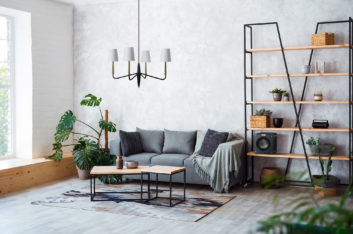 Custom installers are experts in creating bespoke physical environments, but how much of a challenge will come from virtual environments going forward? Is it conceivable that users will opt to watch movies within a virtual metaverse rather than a physical home cinema?
Custom installers are experts in creating bespoke physical environments, but how much of a challenge will come from virtual environments going forward? Is it conceivable that users will opt to watch movies within a virtual metaverse rather than a physical home cinema?
“Absolutely,” cautions Kenny. “If the metaverse can offer up a new kind of movie format whereby you can virtually walk through the movie set as the story unfolds, or where you can access the characters or actors off-camera. Another dimension which the metaverse will offer is co-creation and participation: if you would like to modify the musical soundtrack in certain scenes or see yourself or a personal avatar in the title role, why not?”
EARLY HINTS
2021 saw some early innovations and experiments that hint at what the metaverse may eventually deliver.
“There has already been huge momentum in conceptualizing what a metaverse future will look like. Without a doubt, there are really endless possibilities and its application to work, entertainment, gaming and social networking will be profound. One of the biggest topics to me personally is the question of ‘who’ will own or run the metaverse. The decentralised version of the metaverse will be a collection of experiences and portals created by independent organizations which strive to meet the needs of many people and which allow for ‘permissionless’ experiences.
“The centralised version of the metaverse will be where one to three mega companies run the entire metaverse experience, and therefore, we will be at the mercy to live within the ‘permissions’ they grant. These scenarios will play out openly in the next few years – I personally hope for a decentralized version, allowing our digital selves to exist outside the confines of the commercial needs of a few mega companies.”
Intriguingly, Kenny suggests that 3D audio will become the standard format within this new digital landscape.
“What I find exciting about music audio in the metaverse is the old Marshall McLuhan saying ‘the medium is the message.’ Radio brought us the hit single concept, TV brought us the music video format, Spotify brought us the personal playlisting experience and the metaverse will bring something really new and exciting – we can only assume that it will harness all the benefits of the metaverse like spatial audio, full immersion, long-form, personalization and co-creation. Loudly is building the music engine for the metaverse with a goal to enable anyone to define and generate their own soundtracks; we want to empower everyone with their own musical kit.”

